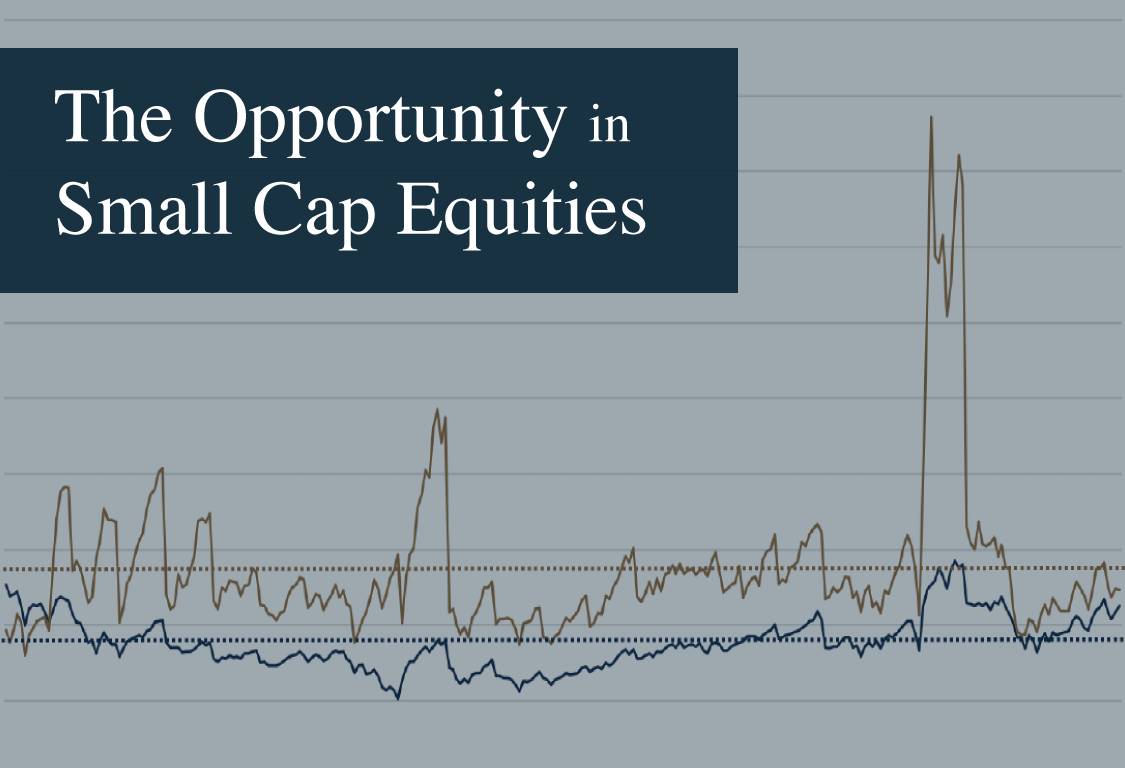To end the most recent quarter, the Russell 2000 posted its worst half- year in history relative to the S&P 5001, with the S&P 500 delivering a 15.0% gain for the year to date through June 30 vs. the far more muted 1.7% for the Russell 2000. Fueled by a handful of big tech stocks, the S&P 500’s return far surpassed its historical average gain for the first six months of the year (roughly 7% since the early 1970s)2. We believe this historically wide difference in returns presents a compelling case for investing in small cap stocks.
The performance gap between the two asset classes for the year to date punctuates an extended period of underperformance for small cap equities. The average three-year return of the Russell 2000 through the year to date is just 1% vs. its three-year average rolling annual return of 11% since the index’s inception in 19783. It follows that based on P/E and EV/EBIT ratios, the Russell 2000 is still trading below historical average metrics, while the S&P 500 is trading well above them4. It is logical to conclude that small cap equities are already on their way to discounting a recession, creating a scenario for strong relative returns if a recession does indeed occur, and a period of strong absolute returns if it doesn’t.

While it is a fool’s errand to try to determine when the market will look more favorably upon small cap equities, the historically large divergence in performance and valuation metrics brings to mind the concepts of diversification and mean reversion.
The Case for Active Management and our Investment Framework at VELA
Compared to Large Cap peers, Small Cap equities can be more volatile and economically sensitive. Many small cap companies are less established, have less scale, and often less favorable access to financing than large cap companies, which can make them less resilient to adverse macroeconomic events. It’s no secret that on average, roughly 40% of equities included in the Russell 2000 are not profitable and therefore more reliant on external financing that is typically provided on less favorable terms6. In addition, many names in the index are neither large enough nor traded enough to invite coverage by the broader sell side community. Over the years, we have found that many small companies with the potential to realize accelerating growth of new products and/or new innovations are overlooked. Astute capital allocation decisions can also have a larger positive impact on smaller companies, and smaller businesses are often targeted by larger companies.
Active security selection can work to navigate the inherent risks in small cap equities and capitalize on compelling opportunities. At VELA, our approach to portfolio management is centered on intrinsic value investing with a long-term time horizon and an emphasis on balance sheet strength, which we believe is integral to success in the small cap space. Our Investment Team was founded by individuals who have worked together and employed this framework to navigate multiple investment cycles. Following industries and sectors for a decade or more creates a holistic knowledge of the cycles, competitors and management teams in a given industry or sector which, when combined with our valuation work, gives us the confidence to build significant positions in businesses we estimate to be undervalued as opportunities arise.
The VELA Small Cap Fund (The Fund)’s smaller asset size allows us to invest in opportunities that would be challenging for larger strategies to invest in due to the category’s relatively low liquidity. We intend to maintain this agility as our Investment Team has long been committed to capacity discipline throughout our careers.
We believe another distinction in our approach to investing is our ability to use covered calls in the Fund. While there is not an active options market for every security we own in the Fund, we do often identify opportunities to write covered calls on many of our Fund holdings. We have found that broader inefficiencies in small cap equities also extend to the options market for many small cap securities. If we see an opportunity to write a covered call at a strike price that is at or above our estimate of intrinsic value, and receive a premium that provides an attractive yield, we will write covered calls on a portion of our underlying position. This can provide extra income, some downside protection, and some protection as we wait for a large gain to go long term for tax efficiency, as well as reinforce our sell discipline. In addition, pricing and volume in the options market can also give us another view of investor sentiment, often providing additional insights into the variables driving price and volume activity in our investments.
In summary, VELA’s Small Cap investment team believes many signals point to a favorable time to invest in small cap equities. Active management can work to navigate the inherent volatility, risks and opportunities in small cap equities. We at VELA adhere to an investment framework that has enabled us to deliver strong relative risk adjusted returns in a tax efficient manner since the inception of the Fund.
Disclosures:
Investors should carefully consider the investment objectives, risks, and charges and expenses of the fund before investing. The prospectus contains this and other information about the fund, and it should be read carefully before investing. Investors may obtain a copy of the prospectus by calling 833-399-1001.
The fund is distributed by Ultimus Fund Distributors, LLC. (Member FINRA). VELA Investment Management, LLC and Ultimus Fund Distributors, LLC are not affiliated.
Performance data quoted represents past performance. Past performance does not guarantee future results. The investment return and principal value of an investment will fluctuate so that an investor’s shares, when redeemed, may be worth more or less than their original cost. Current performance may be lower or higher than the performance data quoted. Investors may obtain performance data current to the most recent month-end by calling 833-399-1001.
As of 6.30.2024 the annualized Total Return for the I-Shares 1-year was 13.66%, 3-year was 6.21%, and since inception (09.30.2020) was 18.82%.
The expense ratio of the VELA Small Cap Fund (Class I) is 1.16%.
Important Risk Information: An investment in the Fund involves risk, including possible loss of principal. The principal risks of investing in Funds include equity, market, management and non-diversification risks. The market value of a security or instrument may decline due to general market conditions that are not specifically related to a particular company, such as real or perceived adverse economic conditions, changes in the general outlook for corporate earnings, changes in interest or currency rates or adverse investor sentiment generally.
A complete list of portfolio holdings can be found at www.velafunds.com.
The VELA Small Cap Fund invests in a diversified portfolio of small capitalization stocks. Investments in smaller companies may be riskier, less liquid, more volatile and more vulnerable to economic, market and industry changes than investment in larger, more established companies.
The Russell 2000 Index is an unmanaged market capitalization-weighted index comprised of the smallest 2,000 companies by market capitalization in the Russell 3000 Index, which is comprised of the 3,000 largest U.S. companies by total market capitalization.
The S&P 500 Index is a composite of the 500 largest companies in the United States. The S&P 500 Index is unmanaged and does not represent the performance of any particular investment.
You cannot invest directly in an index.
Intrinsic Value is a measure of what an asset is worth, arrived at by means of an objective calculation or complex financial model. Intrinsic value is different from the current market price of an asset. However, comparing it to that current price can give investors an idea of whether the asset is undervalued or overvalued.
The Price to Earnings (P/E) Ratio is calculated by dividing the market value price per share by the company’s earnings per share. A high P/E ratio can mean that a stock’s price is high relative to earnings and possibly overvalued. A low P/E ratio might indicate that the current stock price is low relative to earnings.
The Enterprise Value to Earnings Before Interest and Tax (EV/EBIT) Ratio is a metric used to determine if a stock is priced too high or too low in relation to similar stocks and the market as a whole. A high ratio indicates that a company’s stock may be overvalued. Conversely, a low EV/EBIT ratio indicates that a company’s stock may be undervalued.
Option refers to a financial instrument that is based on the value of underlying securities, such as stocks, indexes, and exchange-traded funds (ETFs). An options contract offers the buyer the right (but not the obligation) to buy or sell—depending on the type of contract they hold—the underlying asset. For a Call Option, the option buyer purchases the right to buy a security at a specified price at any point before an agreed-upon expiry date in return for a premium which is paid to the option seller. For a Put Option, the option buyer purchases the right to sell a security at a specified price at any point before an agreed-upon expiry date in return for a premium which is paid to the option seller.
Strike Price: Long options contracts are derivatives that give the holders the right but not the obligation to buy or sell an underlying security at some point in the future at a pre-specified price. This price is known as the option’s strike price or exercise price. The strike price of a call option is where the security can be bought by the option holder. The strike price of a put option is the price at which the security can be sold.
Sources:
(1) Bloomberg
(2) Factset
(3) Factset
(4,5) Factset (based on available data beginning 10/31/2000), Chart: VELA Investment, Management, LLC
(6) Apollo
Author

Jenny Hubbard
Jun 16, 2020

